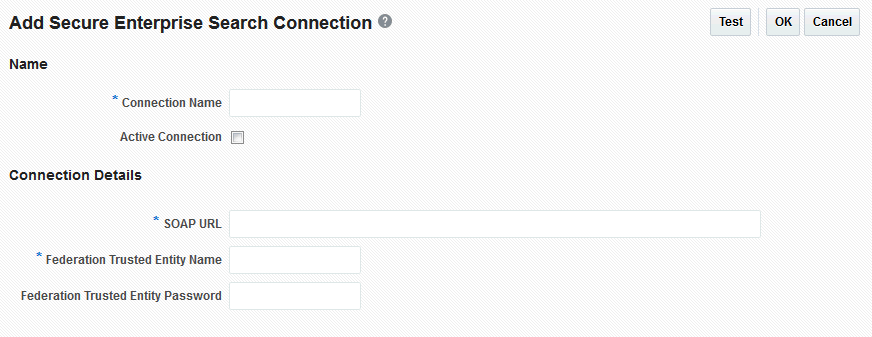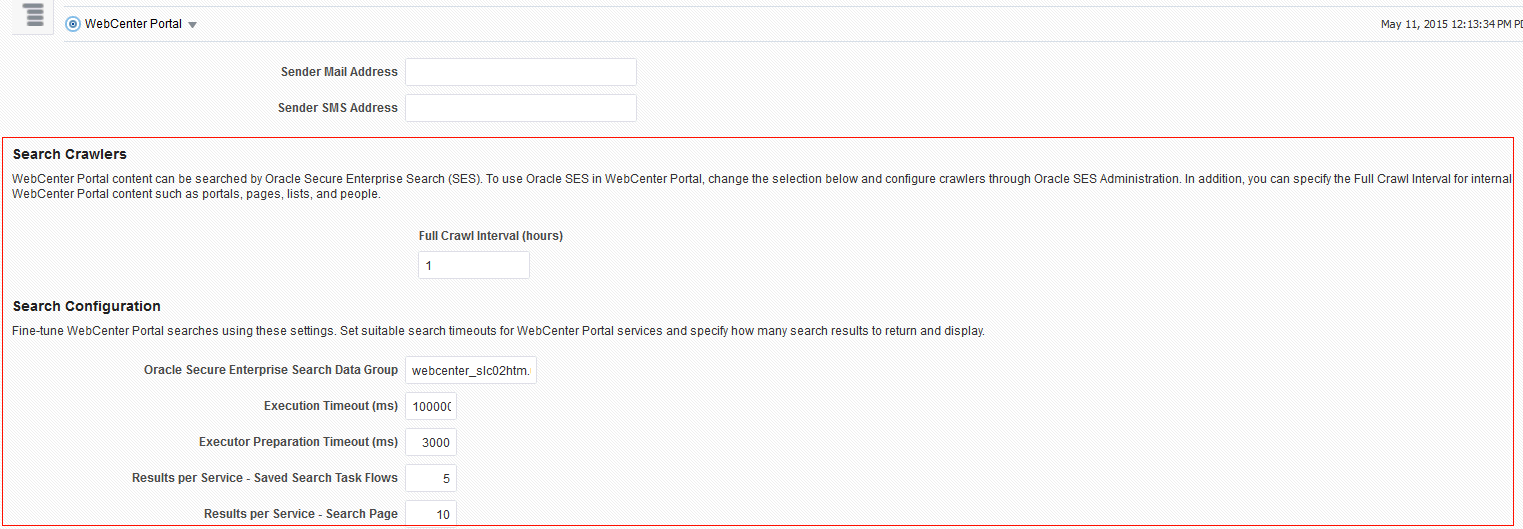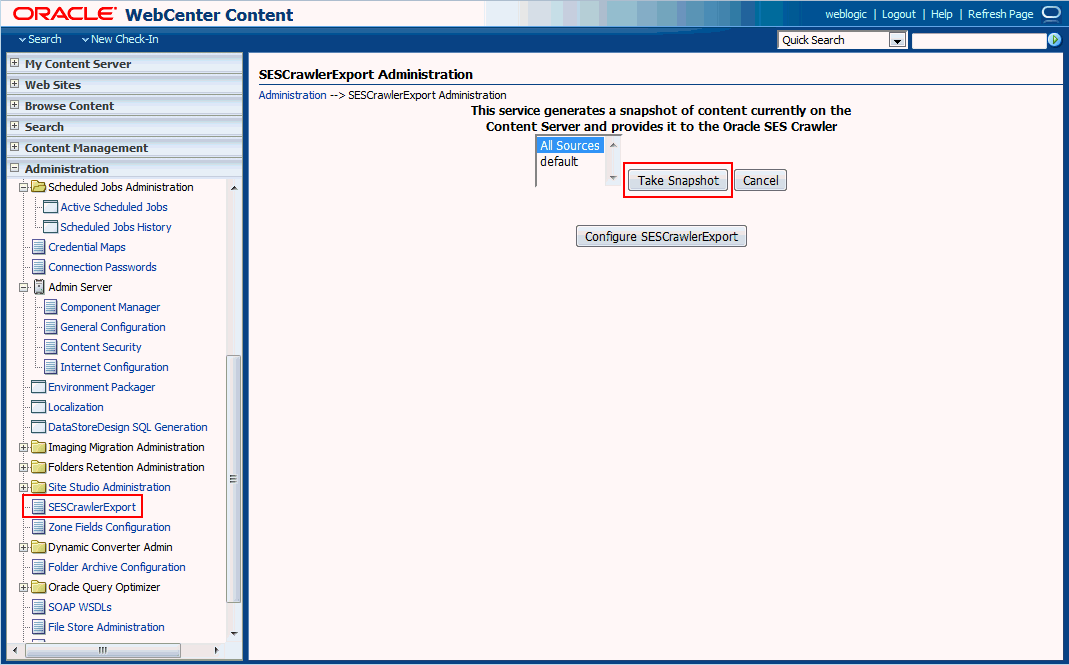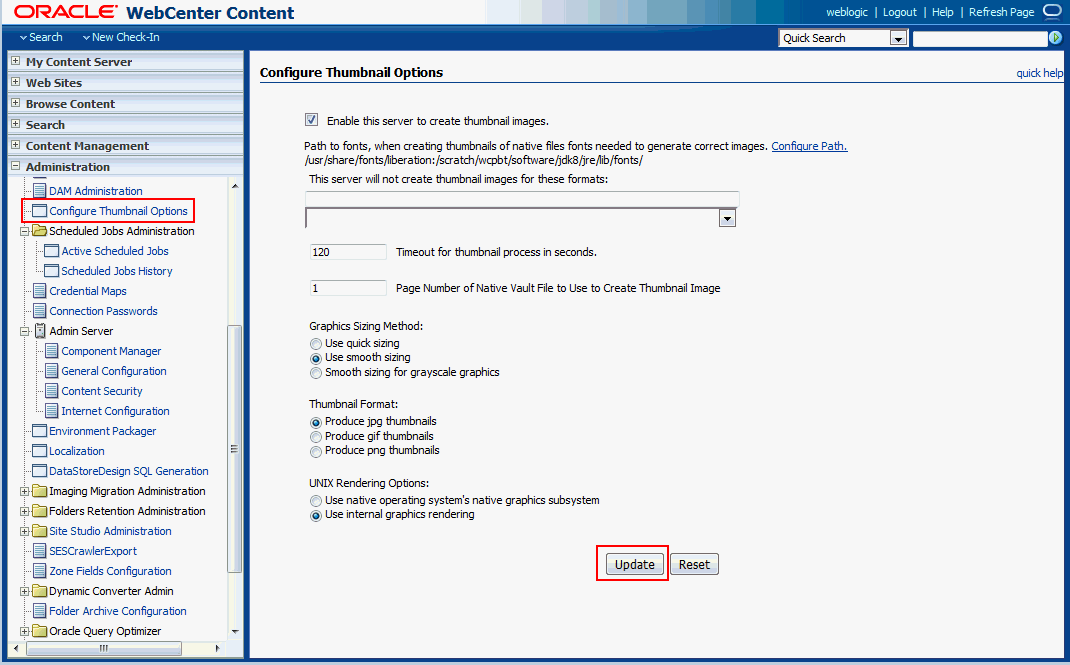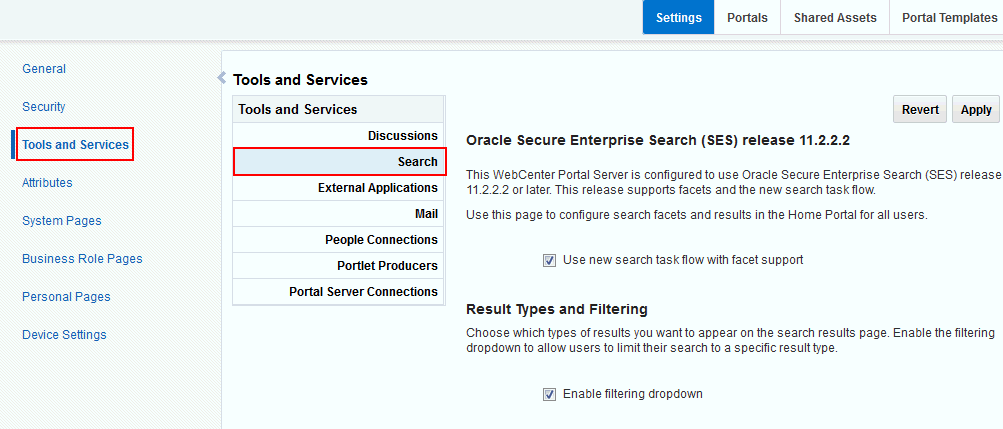15 Managing Oracle Secure Enterprise Search in WebCenter Portal
This chapter includes the following topics:
Permissions:
To perform the tasks in this chapter, you must be granted the WebLogic Server Admin role through the Oracle WebLogic Server Administration Console and the Administrator role granted through WebCenter Portal Administration.
For more information about roles and permissions, see Understanding Administrative Operations, Roles, and Tools.
15.1 About Search with Oracle SES
In prior releases, Oracle SES was set as the default and preferred search platform. Oracle SES provides the following benefits and features:
-
Oracle SES provides unified ranking results, with the most relevant items appearing first.
-
Oracle SES provides a thorough search. For example, when searching lists, Oracle SES searches list column names and column contents.
-
Oracle SES allows search of other repositories outside of WebCenter Portal.
-
Oracle SES supports the search REST APIs and data controls for customizing your search interface.
-
You can customize search in the administration settings for the application. Oracle SES 11.2.2.2 supports faceted search, filtered search in the search box, and document thumbnails. In WebCenter Portal Administration, all customization with Oracle SES 11.2.2.2 is done on the Tools and Services - Search administration page, even though task flow parameters may display.
-
You can configure Oracle SES to search the following resources:
-
Documents, including wikis and blogs
-
Portals, page metadata, lists, and people resources
Note:
When Oracle SES is configured to search WebCenter Portal, other non-crawled resources (for example, notes and events) are not returned in search results.
Results from all sources are listed together, with the most relevant items appearing first. For example, when you run a search for a user name, most likely, you are looking for that person's contact information (that is, the exact user name in People Connections), not necessarily documents that the user wrote.
-
-
You can use three types of Oracle SES crawlers to index WebCenter Portal resources:
-
Documents Crawler: This uses the Oracle SES Content Server source type to crawl documents, including wikis and blogs.
-
Discussions Crawler: This uses the Oracle SES Database source type to crawl discussions and announcements.
-
Spaces Crawler: This uses the Oracle SES Oracle WebCenter source type to crawl certain objects, such as lists, page metadata, portals, and profiles.
Note:
Oracle SES crawlers collect data through connectors to back-end repositories. Each connector is configured in Oracle SES as a "crawl source." Each crawl source has a type that identifies the type of repository that holds the data, such as a relational database or a Content Server repository.
When you configure Oracle SES, all available Oracle SES crawlers should be enabled. It is not recommended to enable one Oracle SES crawler and not another. For example, when you configure Oracle SES you should not have it crawl documents but not discussions.
-
15.2 Configuration Roadmap for Oracle SES in WebCenter Portal
Use the roadmap in this section to guide you through the configuration process:
-
Roadmap - Configuring Oracle SES
Figure 15-1 and Table 15-1provide an overview of the prerequisites and tasks required to get Oracle SES working.
Table 15-1 Configuring Oracle SES
Actor Task Link Administrator
1. Install Oracle SES
Oracle SES – Installation Administrator
2. Configure Oracle SES with an identity management system
Oracle SES – Configuration Administrator
3. Set up a Document Manager in Oracle SES
Setting Up Oracle SES to Search Documents Administrator
4. Create a Federation Trusted Entity using one of the following tools:
-
Oracle SES Admin Tool
-
WLST
Oracle SES – Configuration Administrator
5. Create a crawl user
Setting Up WebCenter Portal for Oracle SES Administrator
6. Create three crawl sources: documents crawler, discussions crawler, and spaces crawler using one of the following tools:
-
Oracle SES Admin Tool
-
WLST
Administrator
7. Create a source group for the crawl sources using one of the following tools:
-
Oracle SES Admin Tool
-
WLST
Additional Oracle SES Configuration Administrator
8. Create facets and sorting attributes
Configuring Oracle SES Facets and Sorting Attributes Administrator
9. Configure a connection between WebCenter Portal and Oracle SES using one of the following tools:
-
Oracle SES Admin Tool
-
WLST
Note: This step must include running the
setSESVersionWLST command to enable the Tools and Services - Search administration page.Registering Oracle Secure Enterprise Search Servers Administrator
10. (Optional) Secure the connection to Oracle SES with SSL
Securing the Connection to Oracle SES with SSL Administrator
11. Configure additional search parameters using one of the following tools:
-
Fusion Middleware Control
-
Oracle SES Admin Tool
-
WLST
Setting Up WebCenter Portal for Oracle SES Application Specialist
12. (Optional) Add a search task flow to a portal
Add a search task flow to a portal in Oracle Fusion Middleware Building Portals with Oracle WebCenter Portal -
15.3 Prerequisites for using Oracle SES
This section includes the following topics:
15.3.1 Oracle SES – Installation
The sections in this chapter assume that you are running Oracle SES 11.2.2.2 and Oracle WebCenter Content Server 12.2.1. These are the only versions supported with WebCenter Portal 12.2.1.
For information about Oracle SES Installation, see Back-End Requirements for Search in Oracle Fusion Middleware Installing and Configuring Oracle WebCenter Portal.
See Also:
It is important to verify that you have installed all required patches for Oracle SES. For the latest information on required patches, check the Release Notes.
15.3.2 Oracle SES – Configuration
Configure Oracle SES with an Identity Management System
Oracle SES must be configured with an identity management system to validate and authenticate users. This is necessary for secure searches, so searches return only results that the user is allowed to view based on access privileges. Because WebCenter Portal uses identity propagation when communicating with Oracle SES, WebCenter Portal's user base must match that in Oracle SES. One way this can happen is by configuring WebCenter Portal and Oracle SES to the same identity management system, such as Oracle Internet Directory.
Note:
For information on all supported identity management systems, see Default Identity and Policy Stores.
Only one identity plug-in can be set up for each Oracle SES instance. All repositories (Oracle WebCenter Content Server, Oracle WebCenter Portal Discussions Server, and Oracle WebCenter Portal) must share the same user base as Oracle SES.
Oracle SES includes numerous identity plug-ins for identity management systems including Oracle Internet Directory, Oracle WebCenter Content Server, and Microsoft Active Directory. For information, see the Oracle SES documentation included with the product. (This is listed on the WebCenter Portal product area on the Oracle Fusion Middleware documentation library.)
If you are using Oracle Unified Directory (OUD) as an identity store, use the plug-in "Sun Java System Directory Server" to configure the OUD identity store.
The following example sets up the identity plug-in for Oracle Internet Directory:
-
In the Oracle SES administration tool, navigate to the Global Settings - Identity Management Setup page, select Oracle Internet Directory from the available identity plug-ins, and click Activate.
-
Provide the following values:
Host name: The host name of the computer where Oracle Internet Directory is running
Port: The Oracle Internet Directory port number
Use SSL:
trueorfalseRealm: The Oracle Internet Directory realm (for example,
dc=us,dc=oracle,dc=com)User name: The Oracle Internet Directory admin user name (for example,
cn=orcladmin)Password: Admin user password
-
Click Submit.
Creating a Federation Trusted Entity
Each Oracle SES instance must have a trusted entity for allowing WebCenter Portal end users to be securely propagated at search time. A trusted entity allows the WebCenter Portal to authenticate itself to Oracle SES and assert its users when making queries on Oracle SES. This trusted entity can be any user that either exists on the identity management server behind Oracle SES or is created internally in Oracle SES.
You can do this either in WLST or in Oracle SES.
Note:
This trusted entity name and password is required later as the appUser and appPassword properties on the WLST command createSESConnection.
To do this with WLST, use the createFederationTrustedEntity command.
Example: createFederationTrustedEntity Command
createFederationTrustedEntity( appName='webcenter', sesUrl='http://mySEShost.com:7777/search/api/admin/AdminService', sesPassword='mySESAdminPassword', entityName='myTrustedEntityUser', entityPassword='myTrustedEntityUserPassword', desc='Trusted entity for WebCenter Portal', sesSchema='eqsys')
For command syntax and examples, see createFederationTrustedEntity in Oracle Fusion Middleware WebCenter WLST Command Reference.
To do this in Oracle SES, follow these steps:
-
In the Oracle SES administration tool, navigate to the Global Settings - Federation Trusted Entities page.
-
Enter a name for a trusted entity. This is the name that WebCenter Portal uses to authenticate itself to Oracle SES at search time (before it propagates the end user identity to Oracle SES).
To allow the entity to be authenticated through the active identity plug-in:
- Make sure that the entity name is the name of a user that exists in the identity management system.
- Leave the password field blank.
- Select the Use Identity Plug-in for authentication checkbox.
- Enter the authentication attribute value corresponding to the Authentication Attribute in your active identity plug-in.
To allow the entity to be authenticated through Oracle SES:
- Enter any user name (for example,
wcsearch) and password (for example,myPassword1).- Do not select the Use Identity Plug-in for authentication checkbox.
For more information, see the online help for the Federation Trusted Entities page in Oracle SES.
Note:
For reference, the following sample user names are used in this chapter:
-
wcsearch: User of the Oracle SES Federation Trusted Entity -
mycrawladmin: Crawl admin user in WebCenter Portal and in the identity management system to crawl certain objects, such as lists, page metadata, portals, and profiles -
sescrawer(or admin user): Crawl admin user in Oracle WebCenter Content Server withsescrawlerrole(oradmin) role
15.3.3 Oracle SES – Security
Most enterprise deployments require that their HTTP connections be secure. SSL (secure socket layer) is an encryption protocol for securely transmitting private content on the internet. Oracle strongly recommends that you use an SSL-protected channel to transmit password and other secure data over networks.
For instructions, see Securing the Connection to Oracle SES with SSL.
15.4 Setting Up Oracle SES Connections
This section includes the following topics:
15.4.1 Testing the Connection to Oracle SES
Confirm the connection to Oracle SES by entering in a browser the URL for Oracle SES Web Services operations:
http://host:port/search/query/
If the URL address does not render in the browser, then either the host or port for the Oracle SES server is incorrect, or Oracle SES has not been started.
15.4.2 Registering Oracle Secure Enterprise Search Servers
You can register multiple Oracle SES connections with a WebCenter Portal application but only one of them is active at a time. You can register connections using either Fusion Middleware Control or WLST.
This section includes the following topics:
15.4.2.1 Registering Oracle SES Connections Using Fusion Middleware Control
To register an Oracle SES instance:
Note:
To start using the new (active) connection you must restart the managed server on which the application is deployed (by default, WC_Portal).
15.4.2.2 Registering Oracle SES Connections Using WLST
Use the WLST command createSESConnection to create a connection to Oracle SES. For example:
createSESConnection(appName='webcenter',
name='mySesConnection',
url='http://myhost.com:7777/search/query/OracleSearch',
appUser='wcsearch',
appPassword='myPassword1',
default=true)
Where, appUser is the user name of the Oracle SES Federation Trusted Entity created in Oracle SES – Configuration.
For command syntax and examples, see createSESConnection in Oracle Fusion Middleware WebCenter WLST Command Reference.
To configure search to actively use a new Oracle SES connection, set default=true. For more information, see Setting the Active Oracle SES Connection Using WLST.
Note:
To start using the new (active) connection or settings, you must restart the managed server on which the application is deployed (by default, WC_Portal).
15.4.3 Choosing the Active Oracle SES Connection
You can register multiple Oracle SES connections with a WebCenter Portal application, but only one connection is active at a time.
Note:
The steps in this section are not required if you selected the active connection in Registering Oracle Secure Enterprise Search Servers.
This section includes the following topics:
15.4.3.1 Choosing the Active Oracle SES Connection Using Fusion Middleware Control
To change the active connection:
Note:
To start using the new (active) connection you must restart the managed server on which the application is deployed (by default, WC_Portal).
15.4.3.2 Setting the Active Oracle SES Connection Using WLST
Use the WLST command setSESConnection with default=true to activate an existing Oracle SES connection. For example:
setSESConnection(appName='app1',
name='SESConn1',
url='http://myhost.com:7777/search/query/OracleSearch',
appUser='wpadmin',
appPassword='password',
default=1)
For full command syntax and examples, see setSESConnection in Oracle Fusion Middleware WebCenter WLST Command Reference.
To subsequently disable an Oracle SES connection, run the same WLST command with default=false. Connection details are retained but the connection is no longer named as an active connection.
Note:
To start using the active connection you must restart the managed server on which the application is deployed (by default, WC_Portal).
15.4.4 Modifying Oracle SES Connection Details
You can modify Oracle SES connection details at any time.
To start using the updated (active) connection you must restart the managed server on which the WebCenter Portal application is deployed.
Note:
The steps in this section are required only to modify the details configured in Registering Oracle Secure Enterprise Search Servers.
This section includes the following topics:
15.4.4.1 Modifying Oracle SES Connection Details Using Fusion Middleware Control
To update connection details for an Oracle SES instance:
Note:
To start using the updated (active) connection you must restart the managed server on which the application is deployed (by default, WC_Portal).
15.4.4.2 Modifying Oracle SES Connection Details Using WLST
Use the WLST command setSESConnection to alter an existing Oracle SES connection. For command syntax and examples, see setSESConnection in Oracle Fusion Middleware WebCenter WLST Command Reference.
Note:
To start using the updated (active) connection you must restart the managed server on which the application is deployed (by default, WC_Portal).
15.4.5 Deleting Oracle SES Connections
You can delete Oracle SES connections at any time but take care when deleting the active connection. If you delete the active connection, users are not able to search content on external repositories.
This section includes the following topics:
15.4.5.1 Deleting Oracle SES Connections Using Fusion Middleware Control
To delete an Oracle SES server connection:
Note:
To effect this change you must restart the managed server on which the application is deployed (by default, WC_Portal).
15.4.5.2 Deleting Oracle SES Connections Using WLST
Use the WLST command deleteConnection to remove an Oracle SES connection. For command syntax and examples, see deleteConnection in Oracle Fusion Middleware WebCenter WLST Command Reference.
Note:
To effect this change, you must restart the managed server on which WebCenter Portal is deployed (by default, WC_Portal).
15.5 Configuring Oracle SES to Search WebCenter Portal
This section describes the steps necessary to set up Oracle SES for WebCenter Portal. It includes the following topics:
Note:
For an overview of the tasks that must be performed to enable Oracle SES as the search engine, see Configuration Roadmap for Oracle SES in WebCenter Portal. There may be various acceptable ways and orders to perform the required tasks.
15.5.1 Setting Up WebCenter Portal for Oracle SES
This section describes how to configure WebCenter Portal to work with Oracle SES.
-
Create and configure the connection between WebCenter Portal and Oracle SES, and optionally specifying a source group.
-
To use Oracle SES to search portals, lists, or page metadata, you must first create a crawl admin user in WebCenter Portal and in your back-end identity management server (for example,
mycrawladmin). You must only create a crawl admin user once.Note:
See your identity management system documentation for information on creating users.
The following example uses Oracle Directory Services Manager to create the
mycrawladminuser.-
On the Data Browser tab, navigate to the target
cnand click Create. This example navigates to "dc=com,dc=oracle,dc=us,cn=Users". In the Add Object Class dialog, select the appropriate object class, and click OK.Figure 15-7 Oracle Directory Services Manager - Add Object Class
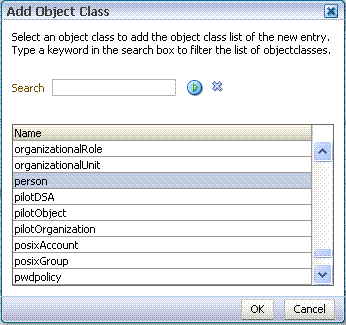
Description of "Figure 15-7 Oracle Directory Services Manager - Add Object Class" -
Find the distinguished name (DN) path, and click Select. This example selects "dc=com,dc=oracle,dc=us,cn=Users".
Figure 15-8 Oracle Directory Services Manager - Select DN Path

Description of "Figure 15-8 Oracle Directory Services Manager - Select DN Path" -
In the Create New Entry dialog, enter properties, and click Next.
Figure 15-9 Oracle Directory Services Manager - Create New Entry
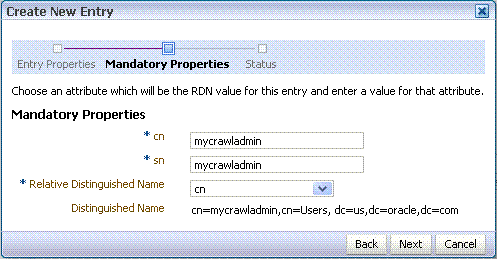
Description of "Figure 15-9 Oracle Directory Services Manager - Create New Entry" -
When you see that the new entry was created successfully, click Finish.
Figure 15-10 Oracle Directory Services Manager - Status

Description of "Figure 15-10 Oracle Directory Services Manager - Status"
-
-
Grant the crawl application role to the crawl admin user created in Oracle SES – Configuration. For example:
grantAppRole(appStripe="webcenter", appRoleName="webcenter#-#defaultcrawl", principalClass="weblogic.security.principal.WLSUserImpl", principalName="mycrawladmin");For command syntax and examples, see Oracle Fusion Middleware WebCenter WLST Command Reference.
Note:
To effect WLST changes, you must restart the managed server on which the application is deployed (by default,
WC_Portal). -
Enable the Oracle SES crawlers in WebCenter Portal.
With the same WLST command, you can set crawler properties (that is, enable/disable the crawlers) and specify an interval between full crawls for the spaces crawler. By default, full crawls for the spaces crawler occur every seven days, but you can specify a different frequency. (Incremental crawls are initiated by the schedule set in Oracle SES.)
For example:
setSpacesCrawlProperties(appName='webcenter', fullCrawlIntervalInHours=168, spacesCrawlEnabled = true, documentCrawlEnabled=true, discussionsCrawlEnabled=true)Note:
The
spacesCrawlEnabled,documentCrawlEnabledanddiscussionsCrawlEnabledparameters all must be set totrueto enable Oracle SES.A clustered instance additionally requires the
serverparameter; for example,server="WC_Portal1".The following example specifies that WebCenter Portal runs a full crawl every 8 days.
setSpacesCrawlProperties(appName='webcenter',fullCrawlIntervalInHours=192)
You also can use WLST to return the current crawl settings for WebCenter Portal, such as the number of hours between full crawls (spaces crawler). For example, the following command returns the current crawl settings.
getSpacesCrawlProperties(appName='webcenter') WebCenter Crawl Properties: ----------------- fullCrawlIntervalInHours: 124 spacesCrawlEnabled: true documentCrawlEnabled: true discussionsCrawlEnabled: true
-
Use Fusion Middleware Control or the
listDocumentsSpacesPropertiescommand to determine the unique name that the back-end Content Server is using to identify this WebCenter Portal application and the connection name for the primary Content Server that WebCenter Portal is using to store documents.For example:
listDocumentsSpacesProperties(appName='webcenter')
The response should looks something like the following:
The Documents Spaces container is "/WebCenter1221" The Documents repository administrator is "sysadmin" The Documents application name is "WC1221" The Documents primary connection is "stxxl18-ucm12g"
Note:
Record the application name and the primary connection returned. These values are required later (in Setting Up Oracle SES to Search Documents) to set up Oracle SES to crawl documents.
Note:
To effect WLST changes, you must restart the managed server on which the application is deployed (by default,
WC_Portal).
15.5.1.1 Configuring Search Parameters Using WLST
Use the WLST command setSearchConfig to modify search parameters.
The following example shows how to specify a data group (also known as source group) under which you search Oracle SES.
Example: Set a Source Group
setSearchSESConfig(appName='webcenter',
dataGroup='mySources')
where dataGroup is the source group you create in Additional Oracle SES Configuration.
The following example shows how to increase the number of search results displayed. Five is the default setting for the number of search results displayed in Oracle SES results, but result sets generally are larger than five.
Example: Increase Number of Search Results Displayed
setSearchConfig(appName='webcenter',
numResultsMain=10)
The following example shows how to configure the maximum time that a service is allowed to execute a search (in ms). When a service times out largely depends on the system load. If you consistently get time out errors, adjust this parameter.
Example: Configure Maximum Time WebCenter Portal Waits for Search Results
setSearchConfig(appName='webcenter',
executionTimeout=10000)
For command syntax and examples, see setSearchConfig in Oracle Fusion Middleware WebCenter WLST Command Reference.
15.5.2 Setting Up Oracle WebCenter Content Server for Oracle SES
This section describes how to configure Oracle WebCenter Content Server to be crawlable by Oracle SES (in particular, the Content Server that WebCenter Portal uses for storing documents).
See Also:
Content Server online help for information on administering roles and users in Content Server
The following steps must be done from within the Content Server.
-
Create a crawl user.
If you want users with the
adminrole to crawl, then use an admin user account as the crawl user.If you want non-admin users to crawl, then follow these steps:
-
Create the role
sescrawlerrole. -
Create the user
sescrawler, and assign it thesescrawlerrolerole. This user creates the Content Server source in Oracle SES. -
Add
sceCrawlerRole=sescrawlerroletoconfig.cfg(located inMW_HOME/user_projects/domains/yourdomain/ucm/cs/config).Alternatively, you can append the
sceCrawlerRole=sescrawlerroleline in the WebCenter Content Server user interface (Administration - General Configuration - Additional Configuration Variables).
-
-
Restart the Content Server.
-
In the Content Server console, install the SESCrawlerExport component on the content server, if not done:
-
Log on to the Content Server as a system administrator. For example:
http://host:port/cs. -
From the Administration dropdown menu, select Admin Server.
Figure 15-12 Content Server Administration
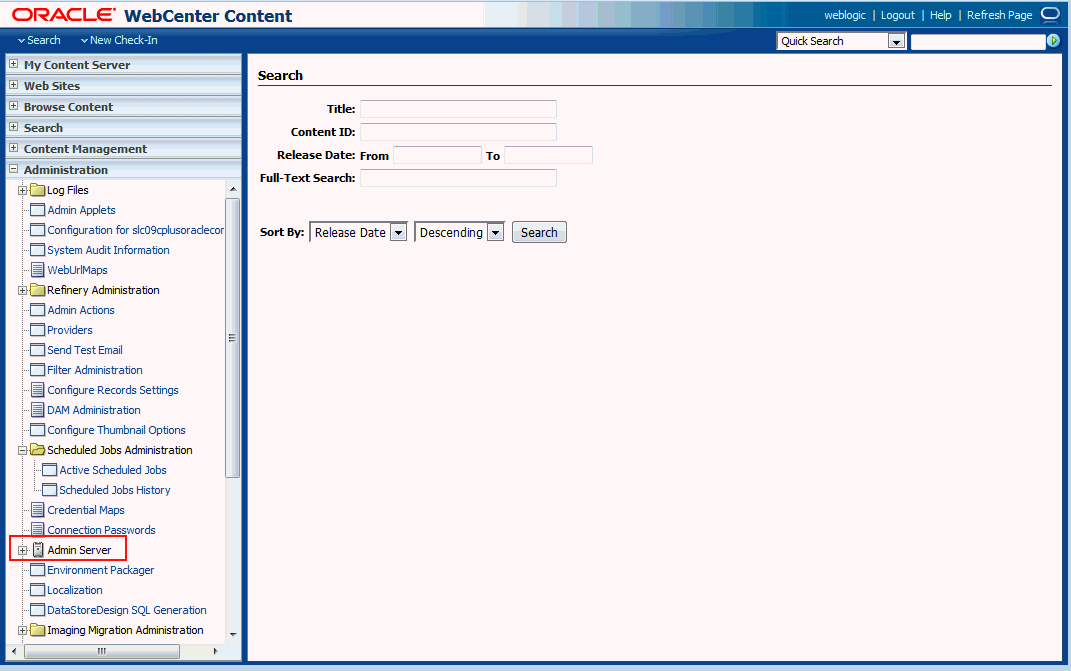
Description of "Figure 15-12 Content Server Administration" -
Click the button with the instance name.
-
Click Component Manager from the menu list on the left pane.
Figure 15-13 Content Server Component Manager
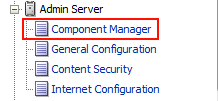
Description of "Figure 15-13 Content Server Component Manager" -
Select SESCrawlerExport under Integration and click Update.
-
Enter configuration parameters. (You can change configuration parameters after installation.)
Disable security on authentication and authorization APIs provided by the SESCrawlerExport; that is, set Disable Secure APIs to
false. This lets security provided by the SESCrawlerExport be done internally instead of by the content server.Additionally, in clustered environments only, the feedLoc parameter must specify a location on the shared disk accessed by the nodes of the Content Server, and they each must reference it the same way; for example,
sharedDrive/dir1/dir2. Note that this is not the default location (relative path) provided. -
Restart the Content Server.
-
-
Take a snapshot of the Content Server repository.
-
Log on to the Content Server as a system administrator. For example:
http://host:port/cs. -
From the Administration dropdown menu, select SESCrawlerExport.
-
Select All sources, and click Take Snapshot.
It is important to take a snapshot before the first crawl or any subsequent full crawl of the source.
The snapshot generates
configFile.xmlat the location specified during component installation, and feeds are created at the subdirectory with the source name under feedLoc.
-
-
If your Content Server is configured to use web rendition, then you must configure the Content Server metatdata list to include the
dFormatvalue, so that required MIME types are exported to Oracle SES. This is necessary to be able to narrow searches by MIME type.If the Content Server is configured for web rendition, then items in the Content Server are rendered in PDF format. The content item's native MIME type rendition is overwritten. For example, the MIME type of a Microsoft Office Word document is 'application/msword', but when the Content Server uses web rendition the MIME type becomes 'application/pdf'. A search query with the
Mimetypeparameter set to 'application/msword' does not return Word documents.-
Back on the SESCrawlerExport Administration page, click Configure SESCrawlerExport.
Figure 15-15 Content Server Snapshot

-
By default, the Metadata List field is blank. Optionally, add to this field any custom metadata values you require (beginning with
x). For example, the following entry for Metadata List includes custom attributes:xCollectionID,xWCTags, xRegionDefinition
Figure 15-16 Content Server Metadata List

Description of "Figure 15-16 Content Server Metadata List"
-
-
Configure Thumbnail Options for faceted search.
-
On the Administration tab, select Configure Thumbnail Options to enable document thumbnails in search results.
-
Leave the default settings as is, and click Update.
-
See Also:
The Deployment Guide.pdf included with the product for detailed information on Content Server configuration.
15.5.3 Setting Up Oracle WebCenter Portal Discussion Server for Oracle SES
This section describes how to configure the discussions server to be crawlable by Oracle SES (in particular, the discussions server that WebCenter Portal uses for storing discussions and announcements).
Note:
These steps are not required if you have a new installation of WebCenter Portal (with an Oracle database) and Oracle WebCenter Portal's Discussion Server. It is only required if you are using upgraded (patched) instances.
You can find database schema details for the corresponding data sources from your Oracle WebLogic Server console.
To configure the discussions server:
- Run the Repository Creation Utility (RCU) to confirm that the discussions crawler WebCenter Portal component has been installed on the system.
- For Oracle and Microsoft SQL Server databases, verify that the Oracle WebCenter Portal's Discussion Server back end has been configured properly by noting that the
MyPrefix_DISCUSSIONSuser is installed in RCU. Then verify that the discussions crawler has been configured properly by noting that theMyPrefix_DISCUSSIONS_CRAWLERuser is installed in RCU. - If the discussions crawler component is not installed, then you must install it using RCU, selecting the same prefix that was used for the Oracle WebCenter Portal's Discussion Server component. Also, during the tablespace specification step in RCU, select
Prefix_IAS_DISCUSSIONSas the default tablespace. This installs the user for Oracle SES.
15.5.4 Setting Up Oracle SES to Search WebCenter Portal
The steps in this section must be performed in the Oracle SES administration tool.
The following steps are required:
- Logging on to the Oracle SES Administration Tool
- Setting Up Oracle SES to Search Documents
- Setting Up Oracle SES to Search Discussions and Announcements
- Setting Up Oracle SES to Search Portals, Lists, People, and Page Metadata
- Configuring Oracle SES Facets and Sorting Attributes
- Additional Oracle SES Configuration
See Also:
Confirm that you have installed all required patches for Oracle SES. For the latest information on required patches, see Back-End Requirements for Search in Oracle Fusion Middleware Installing and Configuring Oracle WebCenter Portal and the Release Notes.
For detailed information about Oracle SES configuration, see the Oracle SES documentation included with the product. (This is listed in the WebCenter Portal product area on the Oracle Fusion Middleware documentation library.)
15.5.4.1 Logging on to the Oracle SES Administration Tool
Open the Oracle SES administration tool:
- Open a browser and enter the URL provided after the Oracle SES installation. (This has the form
http://host:port/search/admin/index.jsp.) - Log on with the Oracle SES admin user name and the password specified during installation.
15.5.4.2 Setting Up Oracle SES to Search Documents
To search WebCenter Portal documents using Oracle SES, you must first set up a Document Service Manager (with a Document Service Instance and a Document Service Pipeline), and then create a Content Server source.
-
Configure the Document Service Manager (one time for each Oracle SES instance).
Note:
Document services are plug-ins involved in the processing of a document when it is being crawled. A document service allows WebCenter Portal to add indexable attributes for documents used in a WebCenter Portal application.
Search attribute names must be unique; two attributes cannot have the same name. For example, if an attribute exists with a String data type, and another attribute is discovered by the crawler with the same name but a different data type, then the crawler ignores the second attribute. Before creating new attributes, make sure to check the list of Oracle SES attribute names and types in the Oracle SES documentation.
-
On the Global Settings - Document Services page, click Create.
-
Select Create New Manager, click Next, and enter the following parameters:
-
Manager Class Name:
oracle.webcenter.search.crawl.ucm.ses.WcUcmDsManager -
Manager Jar File Name:
search-crawl-ucm.jar
Note:
The
webcenter_doc_pipeline_plugin.zipfile installsOracle_Home/search/lib/plugins/doc/search-crawl-ucm.jar.Figure 15-18 Creating a Document Service Manager in Oracle SES
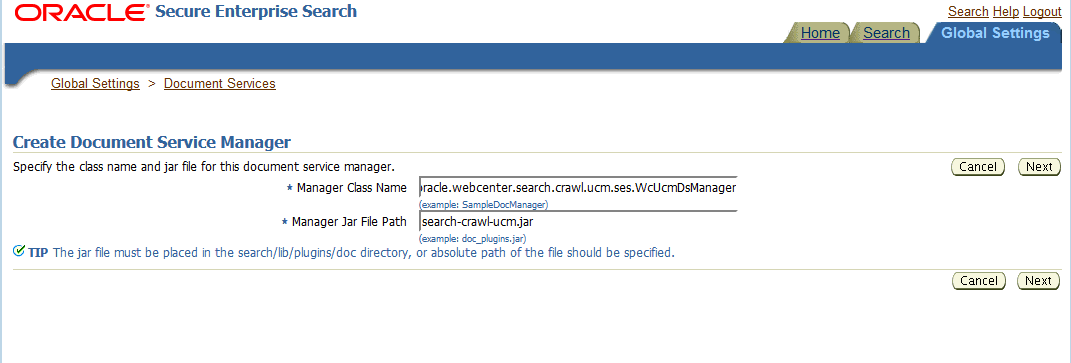
Description of "Figure 15-18 Creating a Document Service Manager in Oracle SES" -
-
Click Next, and then click Finish.
-
Create the Document Service Instance.
-
On the Global Settings - Document Services page, click Create.
-
Select Select From Available Managers with Secure Enterprise Search WebCenter UCM Plugin, and click Next
- Enter the following parameters:
Option Description Instance Name Enter any name here to be used while creating the document pipeline. WebCenter Application Name The unique name being used to identify this WebCenter Portal application in the back-end Content Server. Connection Name The name of the primary Content Server connection that WebCenter Portal is using to store documents. WebCenter URL Prefix The host and port where the WebCenter Portal application is deployed; for example: http://myhost:8888Note:
Use Fusion Middleware Control or the
listDocumentsSpacesPropertiescommand to determine the application name and connection name.
-
-
Create the Document Service Pipeline. This invokes the document service instance.
-
On the Global Settings - Document Services page, under the Document Services Pipelines section, click Create.
Figure 15-20 Creating the Document Service Pipeline

Description of "Figure 15-20 Creating the Document Service Pipeline" -
-
On the Create Document Service Pipeline page, enter any custom name for this pipeline.
The document service instance you created in the previous step should be listed under Available Services. Select that document service instance, and use the arrow button to move it under Used in pipeline.
-
-
Create the Content Server source for documents.
-
Go to Home > Sources.
-
From the Source Type drop-down list, select Oracle Content Server, and click Create.
Figure 15-21 Create Content Server Source

Description of "Figure 15-21 Create Content Server Source" -
Enter the parameters listed in the table:
Figure 15-22 Oracle WebCenter Content Server Source Parameters
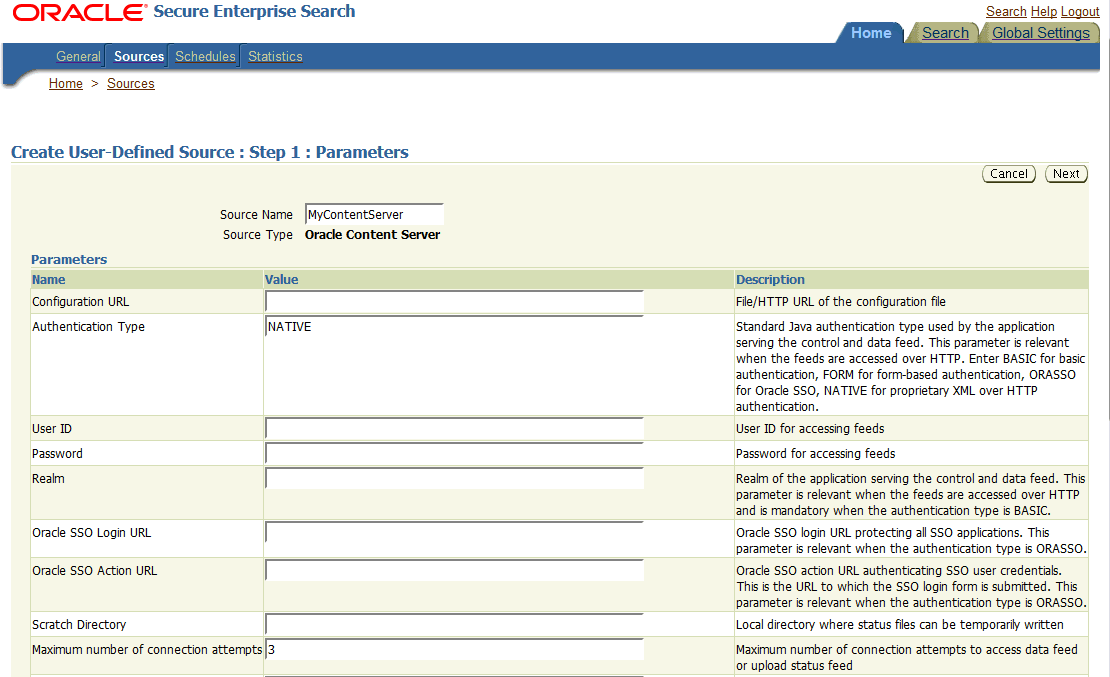
Description of "Figure 15-22 Oracle WebCenter Content Server Source Parameters"Parameter Description Source Name unique_nameConfiguration URL Content_Server_SES_Crawler_Export_endpoint; for example,http://host:port/cs/idcplg?IdcService=SES_CRAWLER_DOWNLOAD_CONFIG&source=defaultNote: The
source=defaultparameter denotes the name of the source created in the configuration of the SES Crawler Export. The default one is created automatically and called "default."Authentication Type -
If authentication is by SSO, then enter
NATIVE -
If the Content Server is protected by Oracle SSO, then enter
ORASSO
User ID The user to crawl the Content Server must have the
sceCrawlerRolerole defined. ThesceCrawlerRoleis a configuration parameter inSESCrawlerExport. Typically, administrators create a special role, assign it no privileges to view content, then create a user account that has this role.If you do not set up a specific
sceCrawlerRole, then admin credentials are required to crawl. Thesysadminuser ID works by default.If Authentication Type is
ORASSO, then enter a user ID (and password) of a user in the identity management server fronted by Oracle SSO. This user must have been granted the same permissions as sysadmin. If it is not possible to grant those permissions, then delete the "remote" user corresponding to this user in the Content Server, and create a "local" version of the user (same name) in the Content Server.Password Password for this Content Server user Realm -
If Authentication Type is
NATIVE, then enterIdc Security /cs/idcplg, where/cs/is the context root you provided when you installing the Content Server. -
If Authentication Type is
ORASSO, then leave this parameter blank.
Oracle SSO Login URL -
If Authentication Type is
ORASSO, then specify a value for Oracle SSO. For example:https://login.oracle.com/mysso/signon.jsp?site2pstoretoken= -
If Authentication Type is
NATIVE, then leave this field blank.
Oracle SSO Action URL -
If Authentication Type is
ORASSO, then specify a value for Oracle SSO. For example:https://login.oracle.com/sso/auth -
If Authentication Type is
NATIVE, then leave this field blank.
Scratch Directory Optional. Specify a directory on the system under which the Oracle SES instance resides. -
-
Click Next.
-
On the Create User-Defined Source: Step 2: Authorization page, enter the following parameters in the Authorization Manager section, if not entered by default:
Parameter Description Plug-in Class Name oracle.search.plugin.security.auth.stellent.StellentAuthManagerJar File Name oracleapplications/StellentCrawler.jarHTTP endpoint for authorization For example, http://host:port/cs/idcplgDisplay URL Prefix For example, http://host:port/csAuthentication Type NATIVEorORASSOAdministrator User The user to crawl the Content Server must have the sceCrawlerRolerole defined. ThesceCrawlerRoleis a configuration parameter inSESCrawlerExport. Typically, administrators create a special role, assign it no privileges to view content, then create a user account that has this role.If you do not set up a specificsceCrawlerRole, then admin credentials are required to crawl. Thesysadminuser ID works by default.If Authentication Type is
ORASSO, then enter a user ID (and password) of a user in the identity management server fronted by Oracle SSO. This user must have been granted the same permissions as sysadmin. If it is not possible to grant those permissions, then delete the "remote" user corresponding to this user in the Content Server, and create a "local" version of the user (same name) in the Content Server.Administrator Password Password for crawl admin user Authorization User ID Format Authentication attribute used in the active identity plug-in. To find this value, go to the Global Settings - Identity Management Setup page in Oracle SES. Enter the value of the Authentication Attribute under the Active Plug-in (for example, nicknameorusernameor something else). If you are using the Oracle E-Business Suite R12 identity plug-in, then leave this parameter blank.Realm -
If Authentication Type is
NATIVE, then enterIdc Security /cs/idcplg, where/cs/is the context root you provided when you installing the Content Server. -
If Authentication Type is
ORASSO, then leave this field blank.
-
-
Click Create & Customize (or edit a created source) to see other source parameters.
-
On the Crawling Parameters tab, enter the following crawling parameter:
Document Service Pipeline. -
Click Enable and select the pipeline you created.
-
15.5.4.3 Setting Up Oracle SES to Search Discussions and Announcements
To search WebCenter Portal discussions and announcements using Oracle SES, you must first set up several Oracle SES Database sources: three for discussions and one for announcements. The three discussions sources are for forums, topics in forums, and replies in forums. These separate sources enable users to see search results for forums without also seeing results for all the messages and replies in it.
For example, the discussions sources could have the following:
-
source name
GS_Forumsand View ofFORUMCRAWLER_VW -
source name of
GS_Topicsand View ofTHREADCRAWLER_VW -
source name of
GS_Repliesand View ofMESSAGECRAWLER_VW
The announcements source could have the source name GS_Announcements and a View of ANNOUNCEMENTS_VW.
Note:
There are slightly different steps for Oracle and Microsoft SQL Server databases.
-
Configure the JDBC driver:
-
To crawl a Microsoft SQL Server database, download the appropriate JDBC driver jar files into the
ORACLE_HOME/search/lib/plugins/oracleapplicationsdirectory in Oracle SES.Note:
For Microsoft SQL Server, copy the Microsoft JDBC driver files
sqljdbc.jarandsqljdbc4.jar.If the JDBC drivers for JRE 1.5 and JRE 1.6 are different, (for example:
sqljdbc.jarworks for JRE 1.5 andsqljdbc4.jarworks for JRE 1.6), then perform the following:- Download both the driver jars into the
ORACLE_HOME/search/lib/plugins/oracleapplicationsdirectory in Oracle SES.- Add an entry for the JRE 1.6 version (
sqljdbc4.jarfor SQLServer) of the driver jar to theCLASSPATHelement ofORACLE_HOME/search/config/searchctl.conf.- Restart the middle tier.
-
Update the
drivers.propertiesfile with the following information:DatabaseName:DriverClassName. -
Add the JRE 1.5 JDBC driver jar file name to the classpath in
META-INF/MANIFEST.MFofappsjdbc.jarandDBCrawler.jar.For example, change:
Class-Path: sqljdbc.jar rsscrawler.jar ../../pluginmessages.jar
to
Class-Path: sqljdbc.jar rsscrawler.jar ../../pluginmessages.jar
and change:
Class-Path: appsjdbc.jar
to
Class-Path: appsjdbc.jar
For a
keyattribute that is not namedKEY, change the JDBC driver information in thedrivers.propertiesfile to specify the key attribute name:database_name: driver_class_name, key_attribute_nameFor example, for a key attribute named
ID:oracle : oracle.jdbc.driver.OracleDriver, ID
In the crawling query, use
key_attribute_nameas the alias for the key value column name. In this example,IDis the alias forKEYVAL:SELECT keyval id, content, url, lastmodifieddate, lang FROM sales_only
Oracle and SQL Server databases: The following default drivers are used if none is specified in
drivers.properties:-
Oracle:
oracle.jdbc.driver.OracleDriver -
SQL Server:
com.microsoft.sqlserver.jdbc.SQLServerDriver
-
-
Create the discussions sources or the announcements source.
-
In Oracle SES, go to Home > Sources.
-
From the Source Type dropdown list, select Database, and click Create.
-
Enter the following parameters:
Parameter Description Source Name unique_name; for example,GS_Forumsto crawl discussion forums (orGS_Announcementsto crawl announcements)Database Connection String Enter one of the following:
-
Oracle database:
Enter one of the following:-
jdbc:oracle:thin:@host:port:sid -
jdbc:oracle:thin@host:port/serviceId
-
-
Microsoft SQL Server database: Enter
jdbc:sqlserver://host_or_IP_address:port;database_name
User ID Enter one of the following:
-
Oracle database: The user
MyPrefix_DISCUSSIONS_CRAWLERcreated during Oracle WebCenter Portal's Discussions Server installation -
Microsoft SQL Server database: The user
MyPrefix_DISCUSSIONS_CRAWLERcreated during Oracle WebCenter Portal's Discussions Server installation
Password Password for this user Query Enter one of the following queries:
SELECT * FROM FORUMCRAWLER_VW SELECT * FROM THREADCRAWLER_VW SELECT * FROM MESSAGECRAWLER_VW SELECT * FROM ANNOUNCECRAWLER_VW
-
Use
FORUMCRAWLER_VWfor the source crawling discussion forums. -
Use
THREADCRAWLER_VWfor the source crawling topics in discussion forums. -
Use
MESSAGECRAWLER_VWfor the source crawling replies in discussion forums. -
Use
ANNOUNCECRAWLER_VWfor the source crawling announcements.
URL Prefix The URL prefix for the WebCenter Portal application, including host, port, and application name. For example, http://host:port/webcenterGrant Security Attributes WCSECATTRNote: Previous releases of Content Server used
FORUMIDfor Grant Security Attributes. -
-
Click Next.
-
On the Create User-Defined Source : Step 2 : Authorization page, enter the following parameters (if not prepopulated) in the Authorization Manager section:
Parameter Description Plug-in Class Name oracle.search.plugin.security.auth.db.DBAuthManagerJar File Name oracleapplications/DBCrawler.jarAuthorization Database Connection String Enter one of the following:
-
Oracle database: Enter one of the following:
-
jdbc:oracle:thin:@host:port:sid -
jdbc:oracle:thin@host:port/serviceId
-
-
Microsoft SQL Server database: Enter
jdbc:sqlserver://host_or_IP_address:port;database_name
User ID Enter one of the following:
-
Oracle database: Enter the user
MyPrefix_DISCUSSIONS_CRAWLER -
Microsoft SQL Server database: Enter the user
MyPrefix_DISCUSSIONS_CRAWLER
Password Password for this user Single Record Query falseAuthorization Query Enter the following (on one line):
SELECT DISTINCT forumID as WCSECATTR FROM AUTHCRAWLER_FORUM_VW WHERE username = LOWER(?) UNION SELECT DISTINCT -1 as WCSECATTR FROM AUTHCRAWLER_FORUM_VWSELECT DISTINCT forumID as WCSECATTR FROM AUTHCRAWLER_FORUM_VW WHERE username = LOWER(?) UNION SELECT DISTINCT -1 as WCSECATTR FROM AUTHCRAWLER_FORUM_VW
Note: Previous releases of Content Server used the following authorization query:
SELECT forumID FROM AUTHCRAWLER_FORUM_VW WHERE (username = ? or userID=-1) UNION SELECT f.forumID FROM jiveForum f, AUTHCRAWLER_CATEGORY_VW c WHERE f.categoryID = c.categoryID AND (c.username = ? or userID=-1)
Authorization User ID Format Authentication attribute used in the active identity plug-in. To find this value, go to the Global Settings - Identity Management Setup page in Oracle SES. Enter the value of the Authentication Attribute under the Active Plug-in (for example,
nicknameorusernameor something else).If you are using the Oracle E-Business Suite R12 identity plug-in, then leave the this parameter blank.
-
-
Click Create to complete the source creation.
-
15.5.4.4 Setting Up Oracle SES to Search Portals, Lists, People, and Page Metadata
This section describes how to create the Oracle WebCenter source.
See Also:
Configuring Search Crawlers Using WLST for an alternative way to create the Oracle WebCenter source
15.5.4.5 Excluding Components from the Spaces Crawler
The spaces crawler collects data for searching the following components:
-
oracle.webcenter.peopleconnections.profile(people) -
oracle.webcenter.community(portals) -
oracle.webcenter.page(page metadata) -
oracle.webcenter.list(lists)
Use the URL parameter ?excludedServiceIds to disable search for any of these components. That is, in the Oracle SES administration tool, on the Home - Sources page for the Oracle WebCenter source, the ?excludedServiceIds in the Configuration URL parameter should equal to the comma-delimited list of service IDs to exclude.
Example: Disable Crawling of People Connections Profiles
http://host:port/rsscrawl?excludedServiceIds=oracle.webcenter.peopleconnections.profile
Example: Disable Crawling of Page Metadata
http://host:port/rsscrawl?excludedServiceIds=oracle.webcenter.page
Example: Disable Crawling of Profiles and Page Metadata
http://host:port/rsscrawl?excludedServiceIds=oracle.webcenter.peopleconnections.profile,oracle.webcenter.page
15.5.4.6 Additional Oracle SES Configuration
This section describes the required steps in the Oracle SES administration tool.
-
Create a source group that includes the names of the Content Server, Discussions, Announcements, and WebCenter Portal sources you created.
-
Go to the Search - Source Groups page, and click Create.
-
Enter the same source group name entered in Setting Up WebCenter Portal for Oracle SES.
-
From the Select Source Type dropdown list, select each source type (Database, Oracle WebCenter Content Server, Oracle WebCenter), and then from the Available Sources listed for each source type, move the source you created for that source type into the Assigned Sources list.
-
Click Finish.
-
-
Optionally configure the security filter lifespan. This refreshes the authorization policies for users in the system. It is best to have a short lifespan when user policies change frequently. (This chapter uses Oracle Internet Directory identity plug-in as the example.)
For example, on the Global Settings - Query Configuration page, under Secure Search Configuration, enter
0for Security Filter Lifespan (minutes).Valid values for the security filter lifespan are between 0 minutes (no cache) and 526500 minutes (cache for one year).
-
To index everything, you must force a full crawl for each source; that is, you must change the existing incremental crawl schedule for each source to first process ALL documents.
This step is very important, in that searching does not work unless the content is first indexed completely.
Note:
You can set the schedule for the spaces crawler with the fullCrawlIntervalInHours parameter in WLST or the Full Crawl Interval parameter in Fusion Middleware Control.
Go to the Home - Schedules page, select the source schedule, and click Edit to force a full crawl.
After each source has been crawled, go back to the same page and change the crawl policy back to incremental (index documents that have changed since the previous crawl). Also, in the Frequency section of the page, select a non-manual type for running incremental crawl (for example, weekly or daily).
Note:
Before the first crawl of the Content Server, remember to go to the Content Server Administration page, select SES Crawler Export, and take a snapshot. For more information, see Setting Up Oracle WebCenter Content Server for Oracle SES.
15.5.4.7 Configuring Oracle SES Facets and Sorting Attributes
Facets are Oracle SES objects that let users refine searches by navigating indexed data without running a new search. You must first define facets (using the provided files) in Oracle SES. Facets defined in Oracle SES are picked up in WebCenter Portal though the Tools and Services - Search administration page.
WebCenter Portal provides the following input files to the Oracle SES Admin API command line interface:
-
facet.xml: This configures facets in Oracle SES. -
searchAttrSortable.xml: This defines attributes for absolute sort.
Locate these files in oracle.webcenter.framework/ses/webcenter_portal_ses_admin.zip. Unzip this file, and follow the instructions in the readme.txt file.
Running these two files from Oracle SES creates the following facets:
-
Author -
Last Modified Date -
Mimetype -
Tags -
Scope GUID(This appears as the Portal facet. This value is converted to the portal display name in the search results page.) -
Service ID(This facet does not appear in the user interface. All enabled tools and services display in the search results page.)
Note:
The facet.xml and searchAttrSortable.xml scripts are mandatory. Creating facets in Oracle SES alone is not sufficient for search in WebCenter Portal.
Additionally, the Scope GUID and the Service ID facets are mandatory. Facet names are case-sensitive. You must have these exact facet names.
After you run these files, you can view facets in the Oracle SES administration tool on the Global Settings - Facets page (Figure 15-25).
-
To create a new facet, on the Global Settings - Facets page, click Create.
-
Enter a name for the facet and the search attribute from which the facet value should be generated.
For String facet types, you must also enter the path delimiter. This is a single character used for demarcation for displaying the facet tree hierarchy for the selected facet tree node on the query page, for example, "tools/power tool/drills", where "/" is the path delimiter. You can set it to blank if the facet tree is one-level deep; that is, its nodes do not have child nodes.
-
Click Create and Customize to create a facet and configure its nodes on the Edit Facet page.
You can configure facet nodes for a facet of Date type or Number type. For example, for the Last Modified Date facet, you can create nodes like Last Year, Last Month, Today, Between two specific days, and so on. The Node Configuration tab displays a facet hierarchy in tree format as well as in XML format, where you can add, edit, and delete child nodes for the selected facet node.Note:
Do not modify or delete the
Scope GUIDorService IDfacets. -
After editing the facet nodes, click Apply to save the changes.
Changes you make in Oracle SES are picked up in WebCenter Portal when the Portal Manager goes to the Tools and Services - Search administration page. WebCenter Portal does not detect changes to facets until this Search administration page is opened. WebCenter Portal remembers the facets selected for use by each portal.
15.5.5 Configuring Oracle SES Version Using WLST
You must run the setSESVersion WLST command to obtain and store version information for the Oracle SES instance associated with your default connection. This command enables faceted search and the Tools and Services - Search administration page, which is necessary for customizing search settings with Oracle SES 11.2.2.2. To confirm that the Oracle SES version is set correctly, run the listSESVersion WLST command.
Example 15-1 shows these commands. For full command syntax and examples, see setSESVersion and listSESVersion in Oracle Fusion Middleware WebCenter WLST Command Reference.
Example 15-1 Enable Facet Query and the Tools and Services Search Admin Page
setSESVersion(appName='webcenter', sesUrl='http://myhost.com:5720/search/api/admin/AdminService', sesSchema='searchsys', sesPassword='password' listSESVersion(appName='webcenter', sesUrl='http://myhost.com:5720/search/api/admin/AdminService')
15.5.6 Configuring Search Crawlers Using WLST
You can use WLST commands to create crawlers and to start, stop and delete crawler schedules. These commands let you crawl new data in Oracle SES or delete old crawlers if the configuration data changes.
The following examples show some of these commands. For more information, see createSpacesCrawler in Oracle Fusion Middleware WebCenter WLST Command Reference.
Example: Create a Spaces Crawler in WLST
createSpacesCrawler(
appName='webcenter', host='myWebcenterHost', port='myWebcenterPort',
sesUrl='http://mySEShost.com:7777/search/api/admin/AdminService',
sesPassword='mySESAdminPassword', crawlUser='webcenter-crawl-user',
crawlPassword='webcenter-crawl-user-pw', scratchDir='/tmp',
authUserIdFormat='authentication-id-format', crawlingMode='ACCEPT_ALL',
recrawlPolicy='PROCESS_ALL', freqType='MANUAL', startHour=1,
hoursBetweenLaunches=1, startDayOfWeek='MONDAY', startDayOfMonth=1,
daysBetweenLaunches=1, weeksBetweenLaunches=1, monthsBetweenLaunches=1,
sesSchema='eqsys')
Example: Create a Documents Crawler in WLST
createDocumentsCrawler( appName='webcenter', host='myWebcenterHost', port='myWebcenterPort', sesUrl='http://mySEShost.com:7777/search/api/admin/AdminService', sesPassword='mySESAdminPassword', configUrl='http://myContentServerHost:myContentServerPort/cs/idcplg?IdcService=SES_CRAWLER_DOWNLOAD_CONFIG&source=default', user='ContentServer_crawl_user', password='ContentServerCrawlPassword', scratchDir='/tmp', httpEndpoint='http://myContentServerHost:myContentServerPort/cs/idcplg', displayUrl='http://myContentServerHost:myContentServerPort/cs', realm='Idc Security /cs/idcplg', authUserIdFormat='authentication-id-format', pipelineName='Document-pipeline', crawlingMode='ACCEPT_ALL', recrawlPolicy='PROCESS_CHANGED', freqType='MANUAL', startHour=1, hoursBetweenLaunches=1, startDayOfWeek='MONDAY', startDayOfMonth=1, daysBetweenLaunches=1, weeksBetweenLaunches=1, monthsBetweenLaunches=1, sesSchema='eqsys')
Example: Create a Discussions Crawler in WLST
createDiscussionsCrawler( appName='webcenter', host='myWebcenterHost', port='myWebcenterPort', sesUrl='http://mySEShost.com:7777/search/api/admin/AdminService', sesPassword='mySESAdminPassword', dbConnString='jdbc:oracle:thin:@database-host:database-port:database-sid', user='Jive-crawler-schema', password='Jive-crawler-schema-pw', authUserIdFormat='authentication-id-format', crawlingMode='ACCEPT_ALL', recrawlPolicy='PROCESS_ALL', freqType='MANUAL', startHour=1, hoursBetweenLaunches=1, startDayOfWeek='MONDAY', startDayOfMonth=1, daysBetweenLaunches=1, weeksBetweenLaunches=1, monthsBetweenLaunches=1, sesSchema='eqsys')
Note:
-
For
authentication-id-format, use 'nickname' if the Identity Management plug-in on Oracle SES is set to Oracle Internet Directory; otherwise, use the value of the Authentication Attribute parameter on the Identity Management plug-in on Oracle SES. -
For
database-host, use Oracle WebCenter Portal's Discussion Server database host name -
For
Jive-crawler-schema, use the Discussions server crawler schema name. Determine the prefix from RCU, and usercu-prefix_DISCUSSION_CRAWLER. -
For
sesSchema, the default value issearchsys, which is the default admin user name for Oracle SES 11.2.2.2; however, a different name may have been specified during installation. -
To effect WLST changes, you must restart the managed server on which the application is deployed (by default,
WC_Portal).
15.6 Managing Search in WebCenter Portal Administration
Note:
For best performance and scalability, as well as facet support and easier configuration, the application should be configured to use Oracle SES release 11.2.2.2 or later with the faceted Search task flow.
To manage search settings:


